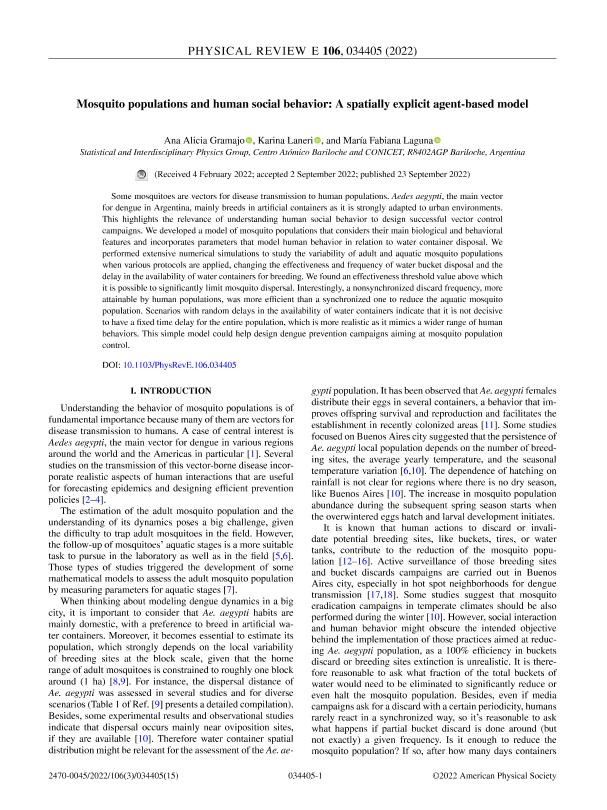Mostrar el registro sencillo del ítem
dc.contributor.author
Gramajo, Ana Alicia

dc.contributor.author
Laneri, Karina Fabiana

dc.contributor.author
Laguna, Maria Fabiana

dc.date.available
2024-01-17T11:54:42Z
dc.date.issued
2022-09
dc.identifier.citation
Gramajo, Ana Alicia; Laneri, Karina Fabiana; Laguna, Maria Fabiana; Mosquito populations and human social behavior: A spatially explicit agent-based model; American Physical Society; Physical Review E: Statistical, Nonlinear and Soft Matter Physics; 106; 3; 9-2022; 1-15
dc.identifier.issn
1539-3755
dc.identifier.uri
http://hdl.handle.net/11336/223888
dc.description.abstract
Some mosquitoes are vectors for disease transmission to human populations. Aedes aegypti, the main vector for dengue in Argentina, mainly breeds in artificial containers as it is strongly adapted to urban environments. This highlights the relevance of understanding human social behavior to design successful vector control campaigns. We developed a model of mosquito populations that considers their main biological and behavioral features and incorporates parameters that model human behavior in relation to water container disposal. We performed extensive numerical simulations to study the variability of adult and aquatic mosquito populations when various protocols are applied, changing the effectiveness and frequency of water bucket disposal and the delay in the availability of water containers for breeding. We found an effectiveness threshold value above which it is possible to significantly limit mosquito dispersal. Interestingly, a nonsynchronized discard frequency, more attainable by human populations, was more efficient than a synchronized one to reduce the aquatic mosquito population. Scenarios with random delays in the availability of water containers indicate that it is not decisive to have a fixed time delay for the entire population, which is more realistic as it mimics a wider range of human behaviors. This simple model could help design dengue prevention campaigns aiming at mosquito population control.
dc.format
application/pdf
dc.language.iso
eng
dc.publisher
American Physical Society

dc.rights
info:eu-repo/semantics/openAccess
dc.rights.uri
https://creativecommons.org/licenses/by-nc-sa/2.5/ar/
dc.subject
MOSQUITOES
dc.subject
SIMULATIONS
dc.subject
GPU
dc.subject.classification
Otras Ciencias Físicas

dc.subject.classification
Ciencias Físicas

dc.subject.classification
CIENCIAS NATURALES Y EXACTAS

dc.title
Mosquito populations and human social behavior: A spatially explicit agent-based model
dc.type
info:eu-repo/semantics/article
dc.type
info:ar-repo/semantics/artículo
dc.type
info:eu-repo/semantics/publishedVersion
dc.date.updated
2024-01-16T10:55:48Z
dc.journal.volume
106
dc.journal.number
3
dc.journal.pagination
1-15
dc.journal.pais
Estados Unidos

dc.journal.ciudad
New York
dc.description.fil
Fil: Gramajo, Ana Alicia. Comisión Nacional de Energía Atómica. Gerencia del Área de Investigaciones y Aplicaciones No Nucleares. Gerencia de Física (cab). División Física Estadística; Argentina. Consejo Nacional de Investigaciones Científicas y Técnicas. Centro Científico Tecnológico Conicet - Patagonia Norte; Argentina
dc.description.fil
Fil: Laneri, Karina Fabiana. Consejo Nacional de Investigaciones Científicas y Técnicas. Centro Científico Tecnológico Conicet - Patagonia Norte; Argentina. Comisión Nacional de Energía Atómica. Gerencia del Área de Investigaciones y Aplicaciones No Nucleares. Gerencia de Física (cab). División Física Estadística; Argentina
dc.description.fil
Fil: Laguna, Maria Fabiana. Comisión Nacional de Energía Atómica. Gerencia del Área de Investigaciones y Aplicaciones No Nucleares. Gerencia de Física (cab). División Física Estadística; Argentina. Consejo Nacional de Investigaciones Científicas y Técnicas. Centro Científico Tecnológico Conicet - Patagonia Norte; Argentina
dc.journal.title
Physical Review E: Statistical, Nonlinear and Soft Matter Physics

dc.relation.alternativeid
info:eu-repo/semantics/altIdentifier/doi/https://doi.org/10.1103/PhysRevE.106.034405
Archivos asociados
